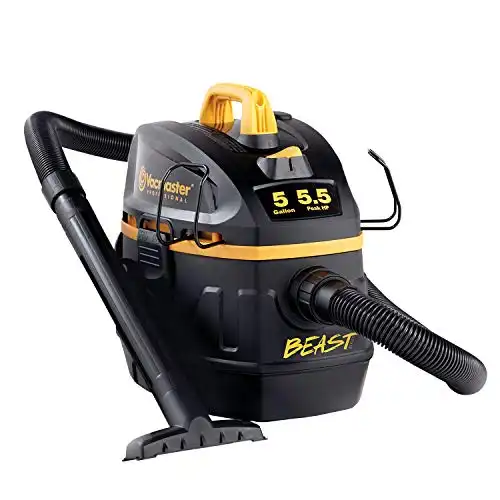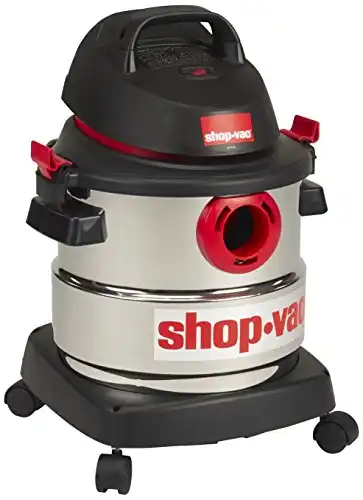As I set up my dream garage, I’m considering buying a dedicated vacuum cleaner for my car. I’ve got a shop vac that I use to clean up spills and clean my garage floor. But I wanted to find the best vacuum for car detailing that didn’t cost a fortune.
Garage vacuums may mean different things to different people. Some people think of heavy-duty wall-mounted vacuums. Others think of handheld vacuum for quick cleaning. Many people think of a shop vac for general use.
It all depends on what you need it for.
Let me say this right off the bat: I am NOT a detailer. I appreciate what those guys do, but I don’t have hours to clean my car each week. I like it to look nice, so I vacuum it out regularly, especially after taking my dog for a ride.
What should you look for in a car vacuum? Garage car vacuums come in several shapes, sizes, and suction strengths. When choosing a new model, the vacuum type is the most crucial aspect to consider. Some of the most common types of garage car vacuums are:
- Wall-mounted
- Handheld
- Wheeled
- Upright
There’s more to buying a garage vacuum than deciding what type to get. We’ll get into some of those factors below.
It may seem like a lot of information, but finding the ideal vacuum for your garage and car can be pretty easy once you know what you’re looking for.
Vacmaster Beast Professional – 5 Gallon Wet/Dry Vac |
Ridgid WD4070 4 Gallon Portable Vacuum |
Shop-Vac 5-Gallon Stainless Steel Wet/Dry Vacuum |
|
Primary Rating:
4.7
|
Primary Rating:
4.5
|
Primary Rating:
4.2
|
Who Needs a Garage Car Vacuum?
But first, why buy a dedicated vacuum for your garage and car in the first place?
Most of us have a Shop-vac or some other brand of canister vacuum, so let me start there.
Think you think about all the ways you use it. In the past few months, I’ve used it to clean up drywall dust, clean out my water-softer tank, and clean up cobwebs and leaves.
When I’m trying to clean dog hair out of my car, I don’t want the possibility of all that stuff falling into my car’s clean interior.
Wet/dry vacs designed explicitly for garages can handle almost anything, but they can still get damaged.
In the same way, if you need a compact model to get into the nooks and crannies of your car’s interior, a handheld vacuum may be the best option.

Types of Garage Vacuums
The first step is understanding the different types of garage car vacuums. This is going to drive your decision process. Understanding your options and choosing the right type can save you a lot of money upfront and frustration down the road.
For our purposes, garage vacuum cleaners fall into four major types: Wall-mounted, canister, handheld, and upright.
Canister or wall-mounted vacuums will probably work best for most garages. Smaller handheld vacuums might fit if you’re short on space. I don’t recommend upright vacuums for car use, but they’re included here for completeness.
People will often buy more than one type, usually because their first vacuum didn’t do something they needed it to do.
Let’s address some of the most common vacuums used to keep garages and cars looking their best.
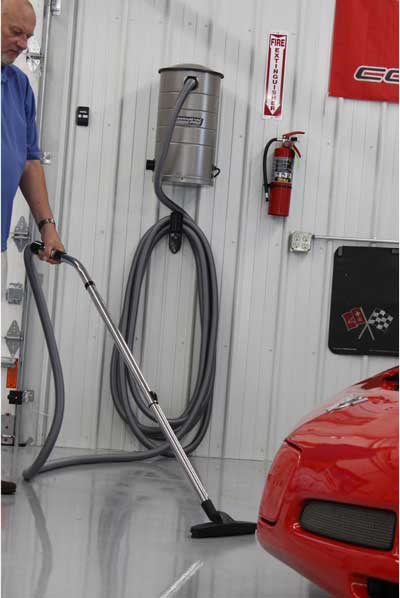
Wall-Mounted Vacuums
Wall-mounted vacuums feature a powerful, stationary body that secures to a wall coupled to an extremely long hose – sometimes up to 50 feet long.
These heavy-duty vacuums are typically the most potent garage vacuums.
While they are generally more expensive than handheld models, they’re easier to use and more convenient to store.
Several of the major models of wall-mounted vacuums aren’t wet\dry vacuums. So if you have a spill in your garage or need to clean your water-filtration system, you’ll need a different vacuum.
In many ways, wall-mounted garage vacuums act exactly like professional vacuums and are best suited for professional car detailing.
However, if you’re looking for a general purpose or wet\dry vacuum, you may want to look elsewhere.
Handheld Cordless Vacuums
At the opposite end of the spectrum are handheld or cordless vacuums.
When they first came out, they were commonly called DustBusters after the popular Black & Decker model, even if they were made by other brands.
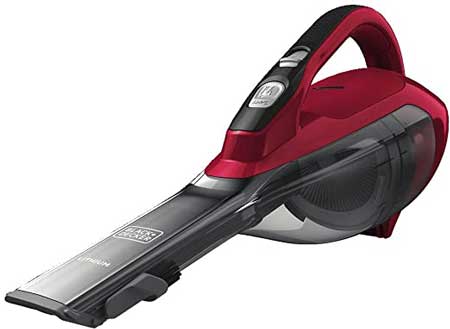
Today, dozens of different brands make some form of handheld vacuum cleaner. While they’re not as flexible as wall-mounted vacuum cleaners, they’re incredibly small and lightweight.
While handhelds are the least expensive garage vacuum cleaner, they’re usually paired with another type of vacuum that can take care of bigger jobs.
Handheld vacuums typically suffer from a lack of power, especially cordless models. I find that the rigid design of the nozzle limits where it can go and what it can pick up.
They’re perfect for quick cleanups or spills and can easily be stored in cabinets and shelves.

Canister (Shop-Vac) Vacuums
Canister vacuum cleaners are often called “shop vacs” or simply “wheeled vacuums.”
They have a large body that houses a powerful motor. Most feature the same flexible tube as wall-mounted vacuums, although significantly shorter.
They are considerably less expensive than wall-mounted vacuums, often under $100. However, it’s common to find industrial canister vacuums that can cost $300 or more.
Because they’re so versatile, canister vacuums are often the only vacuum many people buy for their garages.
They’re portable, powerful, and usually can be both a wet vac and a dry vac.
However, because canister vacuums are good at everything, they’re not usually great at any one thing.
Handheld vacuums are more convenient, and wall-mounted vacuums are more powerful.
Still, if you can only have one vacuum for your garage, go with a canister vacuum.
Upright Vacuums

Most households have at least one upright vacuum. In fact, even my grandmother had an upright vacuum when I was growing up.
They work great on carpeted or tiled interior floors and often come with a set of attachments.
However, they’re not designed for the level of dust and debris that’s in most people’s garages.
Most upright vacuums don’t have the suction power to pick up a dropped screw or nut. They also typically can’t pick up any liquid spills.
Upright vacuums are fine for inside your house, but they’re not recommended for the garage.
What Vacuum Cleaners Do Professional Detailers Use?
Most professional detailers choose a portable canister vacuum to travel to their customers’ homes to detail the car.
Because they need portable vacuum cleaners, professional auto detailers usually go with one of these two vacuums: the Ridgid WD4070 or the VacMaster Beast VFB511B.
In independent tests, both are more powerful than the commercial car detailing vacuums you find at your local car wash.
I’ll go into a little more detail on each below.
Best Vacuum for Car Detailing: Vacmaster Beast Professional
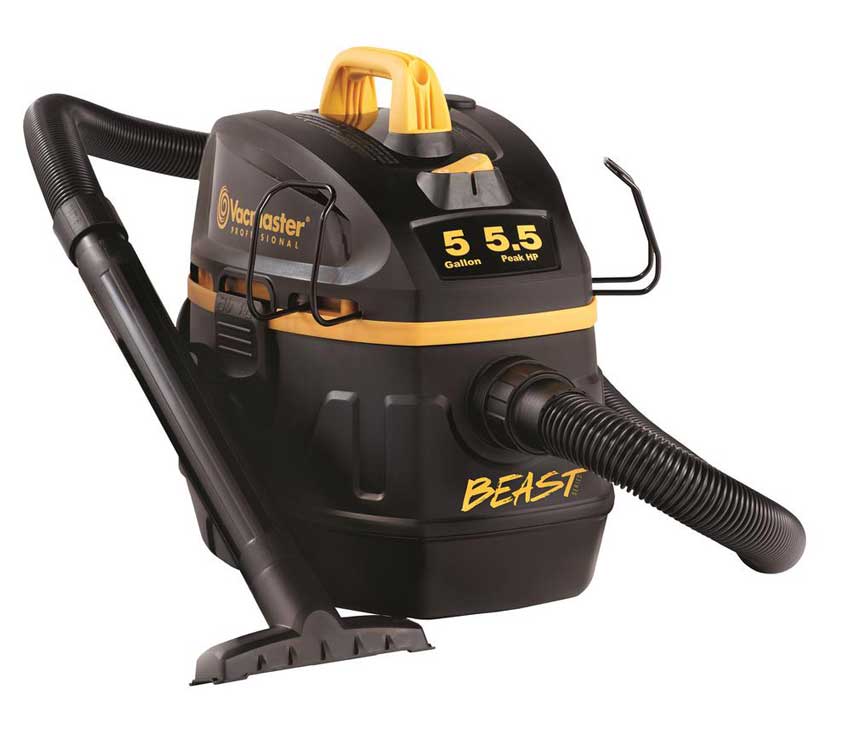
The Vacmaster Beast is…well…a beast!
If you’re looking for a powerful car vacuum, this is it. It even outperforms some commercial models, which you can see in the video above.
The Vacmaster Beast Professional Series costs a little more than the Ridgid below, but it’s better for car detailing.
For the extra price, you get a more powerful motor, better suction power, and a larger capacity drum, so you can go longer between emptying it.
Quite simply, the Vacmaster Beast Professional series is the best car vacuum that I’ve found and the one I use in my home. You can’t go wrong here.
| Drum Size (Gallons) | 5 |
| Cord Length | 18 ft. |
| Hose Length | 7′ |
| Weight | 15.6 lbs. |
| Peak HP | 5.5 |
| Air Volume (CFM) | 102 |
- 5 Gallon Polypropylene Tank
- 5. 5 Peak HP High Efficiency Motor
- Integrated Hose Storage
- 18' Cord with Cord Storage
- Easily Converts to Blower
Runner-Up Car Vacuum: Ridgid WD4070
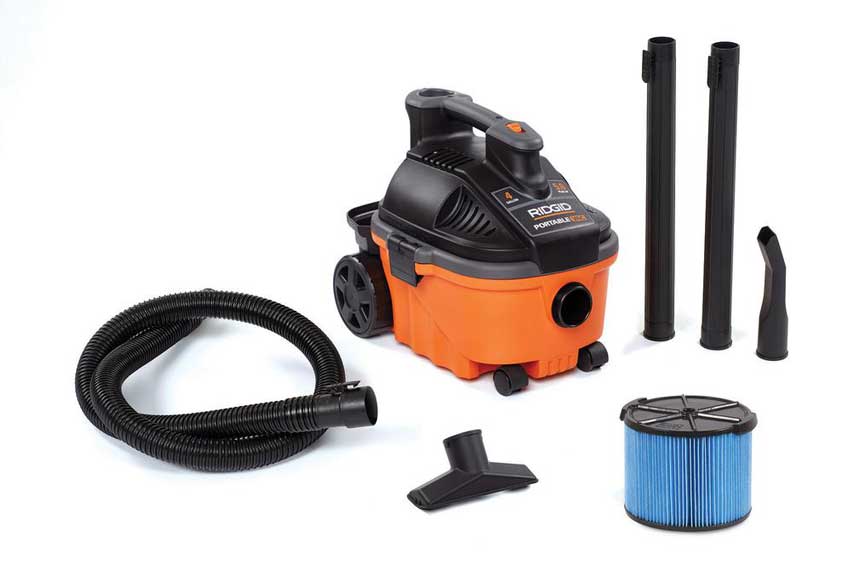
The Ridgid is hands down the most popular vacuum with professional detailers once you add their 6-piece auto detailing accessory kit.
The WD4070 is less expensive than the Vacmaster and slightly less powerful.
However, it does give you wheeled casters, so you can quickly move it around the floor. It also has built-in accessory storage, which the Vacmaster does not.
| Drum Size (Gallons) | 4 |
| Cord Length | 20 ft. |
| Hose Length | 8′ |
| Weight | 12 lbs. |
| Peak HP | 5 |
| Air Volume (CFM) | 110 |
- 5.0 Peak HP motor
- Lightweight vac with large carry handle for extreme portability
- 1-7/8" diameter locking hose won’t pull loose during use
- 20' power cord
- Converts to blower
What To Look For In A Car Vacuum
The type of vacuum might be the most critical factor, but that doesn’t mean it’s the only one to consider.
No matter which type of vacuum you choose, there are other important questions to ask.
Depending on how important these are to you, it may even steer you towards one type of garage vacuum or another.
Consider these questions:
- Does it have the attachments you need?
- What capacity vacuum do you need?
- Do you need a cordless vacuum?
- Do you need to clean up liquid spills as well as dirt?
- Is noise a factor?
Once you can answer those questions, you’ll better understand which garage vacuum cleaner is right for you.
Let’s go into more detail on each.
Attachments
With vacuum cleaner attachments, it’s not the quantity. It’s the quality.
Except for handhelds, most vacuums will come with a wide variety of attachments. What you need to look for, however, are attachments that fit how you will actually use your vacuum cleaner.
Standard attachments include crevice tools, plastic brushes, and nozzles for cleaning floors.
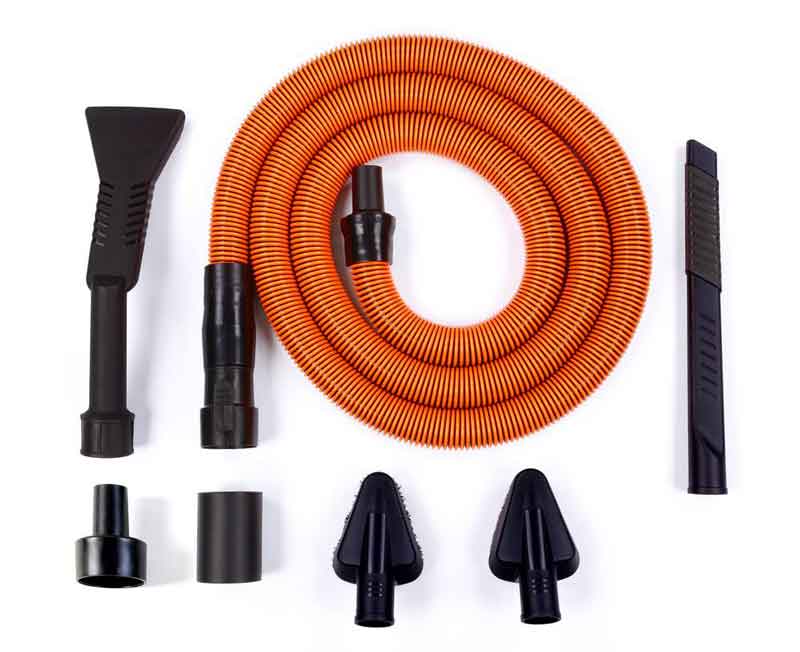
However, you can also get specialty attachments that fit most vacuums (again, except for handhelds).
Some of their attachments include heavier-duty hoses, horsehair brushes for cleaning your car’s vents, and different crevice tools to get in tight spots.
Vacuum Capacity
Capacity measures how much dirt the vacuum can store before emptying the bag or canister. Obviously, larger is better in most cases.
However, with that added capacity comes additional size and weight. You’re going to want to balance the two.
Most vacuums should be able to clean several cars before they need to be emptied.
It’s still worth considering how often you intend to use your garage vacuum cleaner and what you intend to use it for.
Cordless
I go cordless whenever I can. It keeps me (or my dog) from tripping over the cord or pulling it out of the wall.
Cordless options in vacuum cleaners are usually found in handheld or upright vacuum cleaners. You won’t find any cordless canister vacuums yet. And a cordless, wall-mounted vacuum doesn’t make sense.
When looking at a cordless vacuum cleaner, check the battery’s milliamp hours (mAH). The larger the number, the longer the battery will go between charges.
Wet/Dry
Wet/Dry vacuums are almost always either wall-mounted or canister vacuums. So if you need to clean up liquid spills, you’re limited to one of those vacuum cleaners.
As the name implies, Wet/Dry vacs can clean dry and wet messes. However, they usually have to be configured for one or the other.
For example, my canister vacuum has a filter bag for general dry operation.
But I just removed the bag if I wanted to clean up a liquid spill.
Wet/Dry vacuums are usually very powerful and are great for homeowners who use their garage as a workshop.
Low-Noise
As much as we want a vacuum cleaner with powerful suction, we don’t want it to sound like a jet engine.
Both canister and wall-mounted vacuum cleaners tend to be noisier than upright vacuums.
Due to their large metal bodies, the vibration from the motor is amplified.
Handheld vacuums tend to have higher revving, smaller motors. While they’re not as loud as canister vacuums, they will never be accused of being quiet.
Most vacuum cleaners will have a decibel rating in their specs. Look for something that’s around 60 decibels.
That’s the equivalent of everyday conversation.
Frequently Asked Questions
Here’s the section where we’ll answer some of the most frequently asked questions about garage car vacuums.
Hopefully, this information can help you to find solutions to any lingering questions you may have.
Do I Need a HEPA Filter In My Vacuum?
In addition to the five factors we just covered (wet\dry, cordless, capacity, noise, and attachments), consider a vacuum with a HEPA filter.
High-Efficiency Particulate Air (HEPA) filters are special filters that can filter out at least 99.97% of particles that are 0.3 microns in size.
That covers most allergens, pet dander, and tobacco smoke. Vacuums with strong HEPA filtration sacrifice a little suction power but do a much better job improving your air quality in the room.
Can You Vacuum Your Car With a Regular Upright Vacuum?
Technically, yes. You can vacuum your car with a standard household upright vacuum cleaner.
However, I wouldn’t want to try.
Because of their design, upright vacuum cleaners aren’t designed to tackle car interiors or garage floors.
The hose length of an upright vacuum cleaner is usually only a few feet long. That means you’d constantly move the vacuum from one side of the car to the other to reach tight spots.
As we mentioned earlier, upright vacuums aren’t designed to handle the large debris common in garages, like screws, leaves, or small stones.
Still, you can temporarily use an upright vacuum while looking for a better option.
How Often Should You Vacuum Your Car?
I’m guilty of not vacuuming my car as often as I should, but I’m trying to get better about it.
At the bare minimum, you should vacuum your car at least once a month.
Even if you don’t use your car that often, dust and other small particles can get in through the vents and windows and begin to accumulate. The next time you drive your vehicle, you’ll breathe in those particles contributing to allergies.
Industry professionals recommend vacuuming once a week. It’s a great way to keep your interior clean.
In addition, you’ll likely spend ten minutes per week vacuuming instead of an hour every month.
Can You Vacuum the Garage Floor?
Absolutely. In fact, vacuuming your garage floor is far more efficient and effective than sweeping it.
Your garage is already one of the dustiest rooms in your home. While brooms tend to collect dirt and grime while pushing it into the air, vacuum cleaners remove dust particulates from surfaces.
Wrapping It Up
Of the four common types of garage car vacuum cleaners, most homeowners go with either a canister vacuum or the more powerful wall-mounted vacuum cleaner.
They’re usually more expensive than other types, but they’re also the most powerful and easiest to use in your garage.
Handheld models are affordable and lightweight. They make great secondary vacuums to clean up quick spills and get into small areas. They’re also easy to store out of sight.
Whichever type you choose, decide which features are most important to you, and you can’t go wrong.

